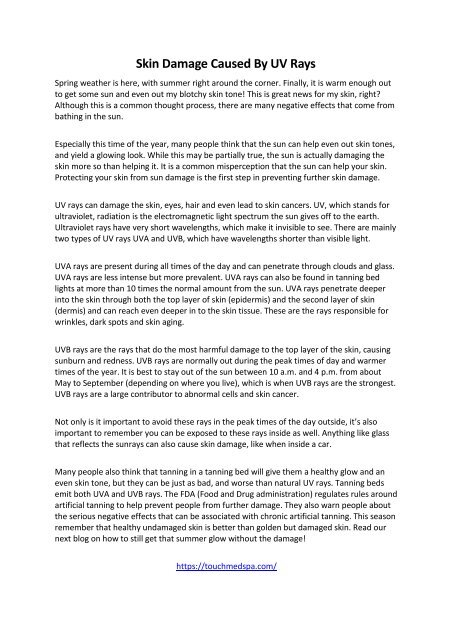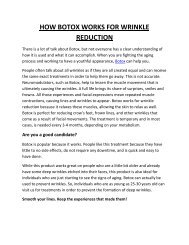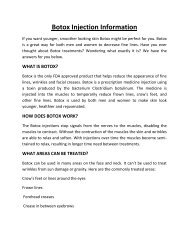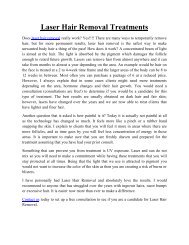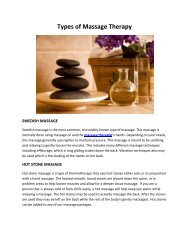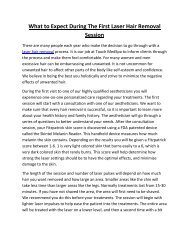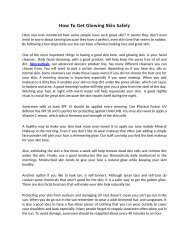Skin Damage Caused By UV Rays
UV rays in the peak of the summer can lead to many skin related diseases. It's important to know how to not only prevent them but also how to get rid of these skin issues. For this, check out the post provided.
UV rays in the peak of the summer can lead to many skin related diseases. It's important to know how to not only prevent them but also how to get rid of these skin issues. For this, check out the post provided.
- TAGS
- rays
- touchmedspa.com
Create successful ePaper yourself
Turn your PDF publications into a flip-book with our unique Google optimized e-Paper software.
<strong>Skin</strong> <strong>Damage</strong> <strong>Caused</strong> <strong>By</strong> <strong>UV</strong> <strong>Rays</strong><br />
Spring weather is here, with summer right around the corner. Finally, it is warm enough out<br />
to get some sun and even out my blotchy skin tone! This is great news for my skin, right?<br />
Although this is a common thought process, there are many negative effects that come from<br />
bathing in the sun.<br />
Especially this time of the year, many people think that the sun can help even out skin tones,<br />
and yield a glowing look. While this may be partially true, the sun is actually damaging the<br />
skin more so than helping it. It is a common misperception that the sun can help your skin.<br />
Protecting your skin from sun damage is the first step in preventing further skin damage.<br />
<strong>UV</strong> rays can damage the skin, eyes, hair and even lead to skin cancers. <strong>UV</strong>, which stands for<br />
ultraviolet, radiation is the electromagnetic light spectrum the sun gives off to the earth.<br />
Ultraviolet rays have very short wavelengths, which make it invisible to see. There are mainly<br />
two types of <strong>UV</strong> rays <strong>UV</strong>A and <strong>UV</strong>B, which have wavelengths shorter than visible light.<br />
<strong>UV</strong>A rays are present during all times of the day and can penetrate through clouds and glass.<br />
<strong>UV</strong>A rays are less intense but more prevalent. <strong>UV</strong>A rays can also be found in tanning bed<br />
lights at more than 10 times the normal amount from the sun. <strong>UV</strong>A rays penetrate deeper<br />
into the skin through both the top layer of skin (epidermis) and the second layer of skin<br />
(dermis) and can reach even deeper in to the skin tissue. These are the rays responsible for<br />
wrinkles, dark spots and skin aging.<br />
<strong>UV</strong>B rays are the rays that do the most harmful damage to the top layer of the skin, causing<br />
sunburn and redness. <strong>UV</strong>B rays are normally out during the peak times of day and warmer<br />
times of the year. It is best to stay out of the sun between 10 a.m. and 4 p.m. from about<br />
May to September (depending on where you live), which is when <strong>UV</strong>B rays are the strongest.<br />
<strong>UV</strong>B rays are a large contributor to abnormal cells and skin cancer.<br />
Not only is it important to avoid these rays in the peak times of the day outside, it’s also<br />
important to remember you can be exposed to these rays inside as well. Anything like glass<br />
that reflects the sunrays can also cause skin damage, like when inside a car.<br />
Many people also think that tanning in a tanning bed will give them a healthy glow and an<br />
even skin tone, but they can be just as bad, and worse than natural <strong>UV</strong> rays. Tanning beds<br />
emit both <strong>UV</strong>A and <strong>UV</strong>B rays. The FDA (Food and Drug administration) regulates rules around<br />
artificial tanning to help prevent people from further damage. They also warn people about<br />
the serious negative effects that can be associated with chronic artificial tanning. This season<br />
remember that healthy undamaged skin is better than golden but damaged skin. Read our<br />
next blog on how to still get that summer glow without the damage!<br />
https://touchmedspa.com/


